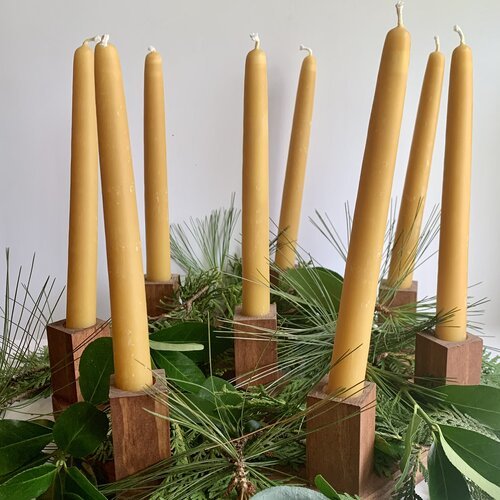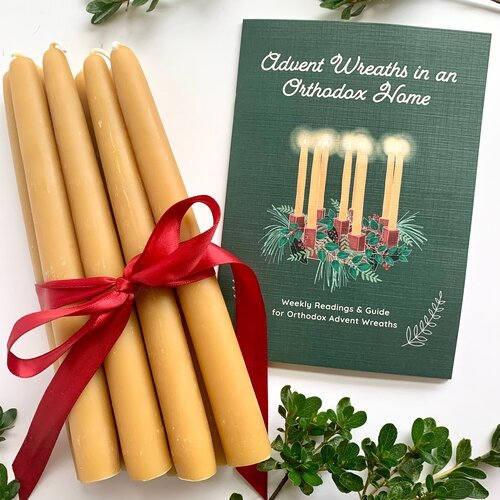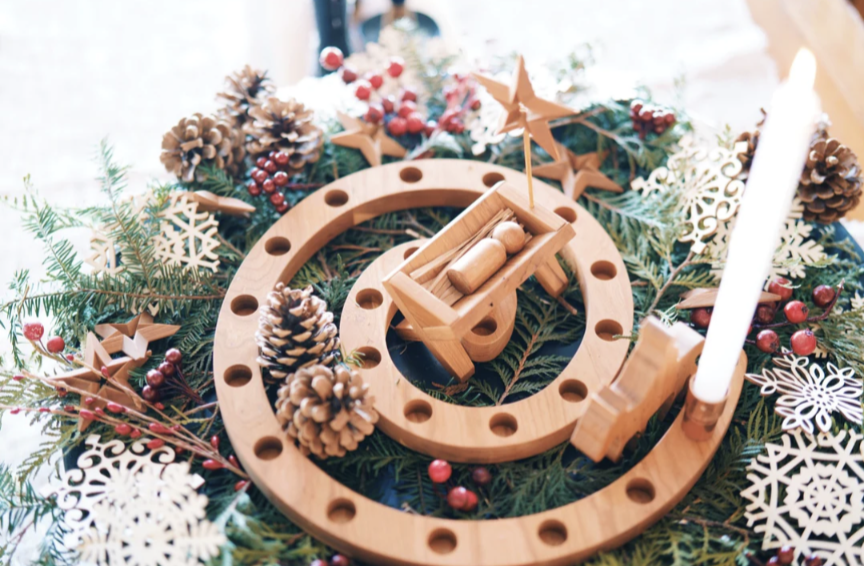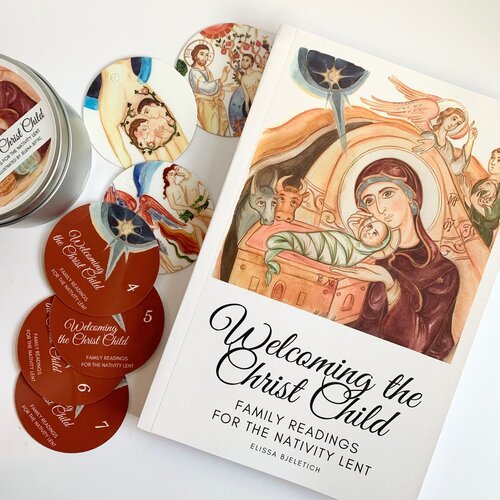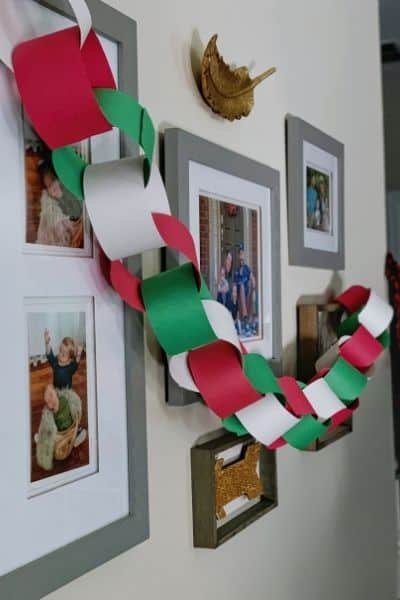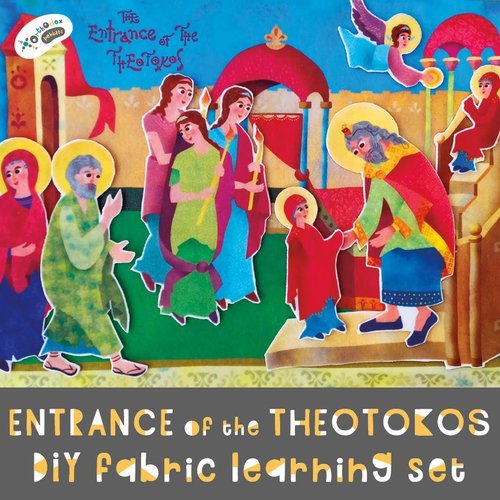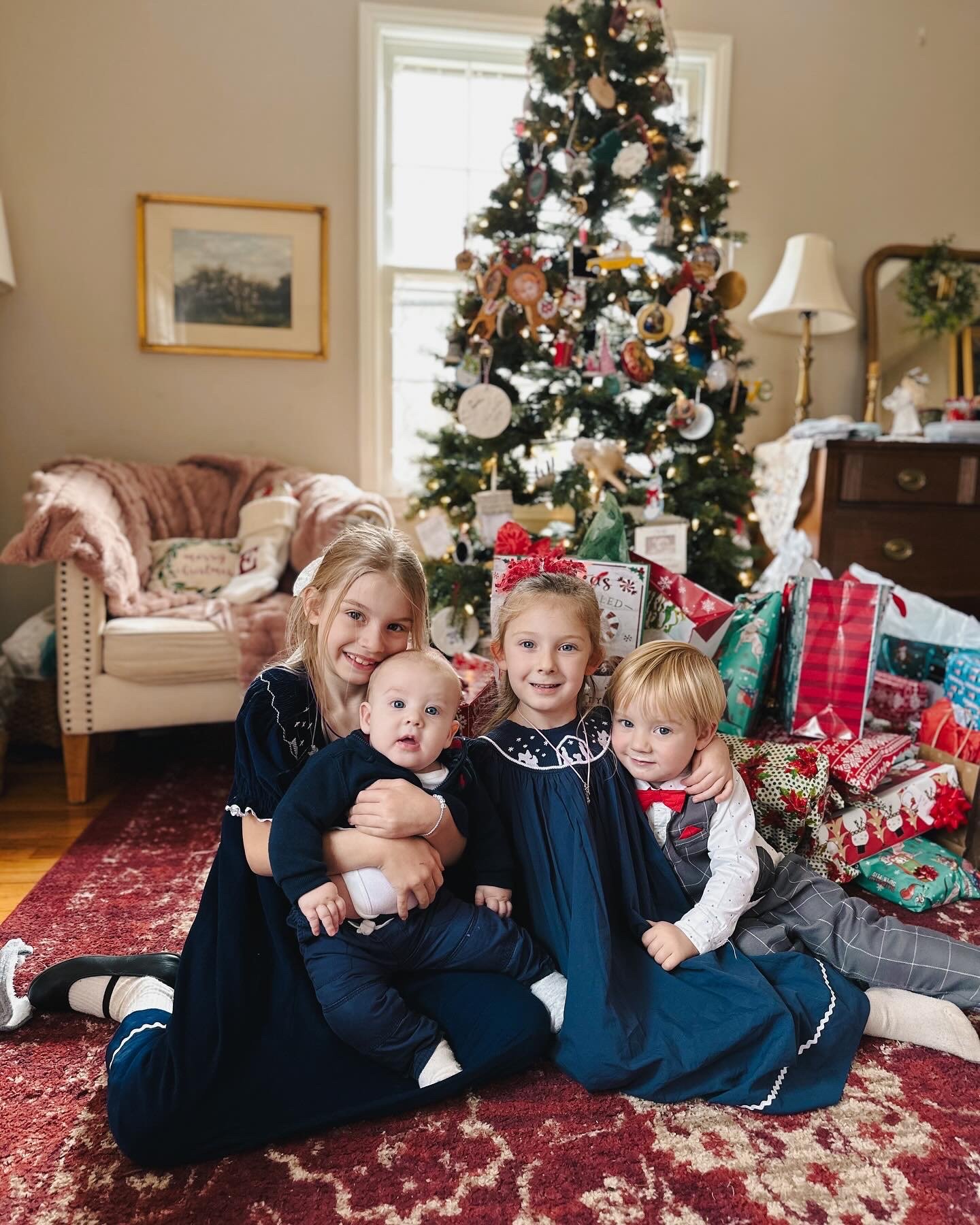Orthodox Nativity Fast Guide
Orthodox Nativity Fast
November 15 - December 24th
The Nativity Fast is a special time for us, set apart, to help us to slow down and prepare our hearts to receive Christ. For Orthodox Christians, Nativity fast begins November 15th and marks the 40 days leading up to the Nativity of our Lord (December 25th). In this guide, I want to share the various resources available to help you mark this season in your homes so that it is a fruitful season for you. Each household will take on their own unique traditions and practices. In my experience, the key to a fruitful Nativity fast is to pair everything down; do ONE thing, do it well, and build from there! God willing we will have many more years to build on foundation we are laying in our homes.
Nativity is a time of preparation, preparing us to receive Christ. The Church, in her wisdom, knows we are weak, and we need lots of time to rid ourselves of our worldly concerns and set our hearts and minds aright. But this time of year is very busy, from a secular perspective. It is easy to get caught up in the myriad of seasonal offerings during this time of year that we can easily lose sight of the task ahead: prepare for the coming Lord! It’s important for us to prepare ahead of time to help ensure we reach our goals for how we want to spend this Nativity season. Even if you haven’t made your plan yet, that’s ok! Today, is a new day! We can begin again. You still have plenty of time. Let’s set our focus on Christ this season.
In this blogpost you will find:
Orthodox Advent Wreath - How to set up an advent wreath and use one!
Nativity Devotionals and Reading Suggestions - including Jesse Tree Readings
Orthodox Advent Calendars
Creating Orthodox Traditions - Celebrating Feast Days during the Nativity Fast
Participating in the Fast - Fasting, Prayers, Services, and Almsgiving
Check out this blogpost with 5 practical ways to embrace the Nativity Fast:
This is my time doing the Nativity Fast, where do I start?
If you are new to fasting or participating in the Church calendar, let me put your mind at ease. It can feel overwhelming - I’ve been in your shoes. The first time I participated in the Nativity fast I was in my mid-twenties, totally new to the Orthodox faith. Fasting alone is difficult work, so let’s pair it down a bit so we can keep our focus on the one thing needful. The first time you go through the Nativity fast, you should plan to do just a little bit. Then maybe next year you add a little more. If we set out to do “all the things” we likely will be setting ourselves up for failure. Because truthfully you won’t be able to do all the things. At least not at first. Evaluate what is reasonable to do this year, speak with your priest about it, make a plan and begin! My suggestion is to plan to keep your focus on these things: PRAY, FAST, GIVE.
Fasting - plan to fast! The Church has offered us a fasting rule, but if you have any questions specifically about how you ought to fast, speak with your priest. Pray - begin (or stay faithful) in practicing a daily habit of prayer (morning and evening) and my suggestion is to attend at least one extra service each week. Give - think of ways to serve the poor and those in need this season. And if you are able, pick up a spiritual book or devotional to read through during the fast. Now, that is plenty enough for you to get started, but if you’re wanting to add one special tradition this year - set out to do ONE thing, and be faithful in that one thing, and add to it in the following years! Some examples, set up an Advent wreath, countdown calendar, celebrate St Nicholas day (Dec 6).
But what is that ONE thing?
(1) Advent Wreath
One of my favorite Nativity traditions is creating an Advent wreath. History of Advent wreaths : Advent wreaths first originated in Germany in 1830 and the story goes that Johann Hinrich Wichern (1808-81), a pastor in Germany, built a wreath out of an old cartwheel to help the children in his mission school count the days until Christmas. He added small candles to be lit every weekday and Saturday during Advent, and on Sundays, a large white candle was lit. Although it wasn’t widely popular until the 19th century, German immigrants then brought the tradition with them to America in the 20th century. This has been a widely practiced tradition in America for sometime, and it has been adapted and used by Orthodox Christians.
An Advent wreath is a wonderful tradition to bring to your home! Although it’s origins did not stem from Orthodox countries, we certainly sanctify everything we do! I like to call it the American contribution to Orthodoxy. A lit candle is a symbol of expectation and hope, especially poignant in the darkness of winter. The candles of the advent wreath can light our homes and warm our hearts as we look forward to the coming of our Lord Jesus Christ.
If you’re unfamiliar with how to use an Advent Wreath, it is a circle of candles that are lit one at a time, increasing by one each week of Advent. There is a candle in the center that is lit on Christmas. The advent wreath is often surrounded by greenery. Every part of the advent wreath contains symbolism that points us back to Christ.
Here is how you set up an Advent Wreath:
Find a prominent place in our home that your family can easily see and gather near. This can be your kitchen table, home altar, or some other prominent place.
Setting up an Advent Wreath - when I first wrote this blogpost, there were no Orthodox Advent wreaths on the market. Now, much to my excitement, there are several options available. The basics of what you will need are 7 candles with holders (some holders have 8 candles to account for the times where there is an extra Sunday during Nativity).
Here are some Advent Wreaths on the Market:
Wooden Advent Wreath Kit through Draw Near Designs
Brass Advent Wreath through Legacy Icons
Cradle-to-Cross Wooden Wreath by The Keeping Company (includes extensions for 40 days)
Beeswax Candles and Booklet available through Draw Near Designs
How to use an Advent Wreath:
Light one candle for each Sunday throughout Advent - On the first day of advent (November 15th), light the first candle. From then on, light one additional candle each Sunday, increasing by one each week. Some Nativity seasons contain only six Sundays, and some only five. If the 7th candle in the circle isn’t needed for a Sunday before Christmas, you can light that one on Christmas Eve. By Christmas Eve, every candle in the circle should be lit, and on the feast of the Nativity of our Lord, you light all of the candles, including the one in the center!
You should use an advent wreath in the way that best suits your family. Some people light the candle(s) every day during evening prayers, or light them and sing a hymn. Others prefer to just light them on Sundays and share the daily Bible readings together. You can also pair the readings from the Jesse Tree, or practice singing the hymn of the Nativity. There is no “right way” to use an Advent Wreath - just find the routine that benefits and blesses your family!
Watch my YouTube video tutorial about the Advent Wreath with Patristic Nectar Kids
(2) Advent Readings, Study and the Jesse Tree
The Antiochian Archdiocese publishes daily readings for each of the 40 days of the fast and the 12 days of Christmas. These are daily scripture readings that take us from Genesis all the way to the birth of Christ, showing us through the scriptures that all things point to Christ! In addition to the readings, some families create a tree with ornaments to use along side the readings. Here are some readings available:
Jesse Tree Daily Readings (updated link) through the Antiochian Archdiocese
Welcoming the Christ Child Book and Ornaments though Ancient Faith or Draw Near Designs
Jesse Tree Wall Hanging for Advent to pair with Welcoming the Christ Child Ornaments
Advent Wreath in an Orthodox Home Booklet only with weekly readings by Draw Near Designs
Behold a Great Light: A Daily Devotional through Nativity Fast (NEW) from Ancient Faith
Meditations for Advent through Ancient Faith
(3) Orthodox Advent Calendar
The marking of time has always been an important part of human existence. For children, this is especially important to help them “mark the time” as we journey through advent. Typical Western advent calendars have 25 days. Because the advent season is longer in Orthodoxy (beginning Nov 15th), you will need a 40 day advent calendar. There are a number of 40 day Advent calendars available now, which has been wonderful to see, or you can choose to create your own! This can be a wonderful way to countdown the days until Nativity with your children.
Fabric Advent Calendar by Draw Near Designs
40 Day Advent Countdown Cards by Draw Near Designs
Holly & Ivy Orthodox 40 day Advent Candle by Parousia Press
(4) Celebrate the Various Feast Days During the Fast
Celebrating the various feasts during the fast is a wonderful way to create traditions that your family will look forward to year after year! This is also a way to bring the life of the church in our homes. For my family, some of our most dear and favorite traditions happen during Advent:
St Martin of Tours (Nov 12th) - see my Martinmas Blogpost for how to celebrate this feast
Entrance of the Theotokos (Nov 21st) - check out Parousia Press on how to celebrate this feast
St Nicholas Day (Dec 6th) - see my St Nicholas Guide for how to celebrate this feast
St Spyridon (Dec 12th) - This is the turning point in the fast as we begin to fast more strictly.
St Lucia Day (Dec 13th) - see my St Lucia Guide for how to celebrate this feast
St Herman of Alaska (Dec 13th) - check out these Spruce Island Cookies for his feast
Nativity of Our Lord (Dec 25th) - check out Parousia Press on how to celebrate the Nativity and the 12 Days of Christmas
(5) Participating in the Fast
Important elements to any fasting period in the Orthodox Church is (1) Prayer, (2) Fasting, and (3) Almsgiving. Find ways for your family to participate in these three things in order to make this season fruitful and as a means for our salvation. Some ways to do this as a family: Attend services, pray together daily and read the scriptures, collect food for a homeless shelter, donate warm coats or blankets to those in need, and connect with your local parish for other opportunities to serve the needy around you.
Make a Plan
This time of year is very busy with all of the cultural things going on that it is easy to get burnt out. Or perhaps you’re like me and start off strong, but 2 weeks in you burn out, having taken on too much. It’s important for us to prepare ahead of time to help ensure we reach out family goals for how we want to spend this advent season. I found this podcast “Preparing for Advent” by Hannah Vasquez of All These Things Podcast very practical and insightful.
Another fantastic resource for making a plan is the Holly & Ivy Orthodox Advent Planners which are available for digital download or bound through Parousia Press.
Fasting
An essential part of every fasting period is the actual fast! As Orthodox Christians, we fast for more than half the year, giving up meat, dairy, eggs, and on strict fast days, giving up oil, wine and fish . By following the prescribed fast of the Church, we are working on our self control, and our hope is by abstaining from foods, we learn to also abstain from sinning. Of course, fasting is a spiritual discipline that should be practiced with the oversight and direction of your spiritual father and priest. You should consult your spiritual father if you have any specific questions about the fasting discipline as it applies to you, and your children. You can read more about the fasting here.
Parousia Press has a wonderful collection of resources for fasting which you can find here
Orthodox Nativity Meal Plan
This year, my friend Zeina’s Table created a Nativity meal plan cookbook for Orthodox Christians that follows the fasting rules set in the Church. I’m so excited to use this this year! It is available for purchase on her website.
As with all fasting, please remember that abstaining from food during this period of preparation does us no good if we do not also, as St. John Chrysostom teaches us, fast with:
… the eye and the ear and the feet and the hands and all the members of our bodies.
Let the hands fast, by being free of avarice.
Let the feet fast, by ceasing to run after sin.
Let the eyes fast, by disciplining them not to glare at that which is sinful.
Let the ear fast, by not listening to evil talk and gossip.
Let the mouth fast from foul words and unjust criticism.For what good is it if we abstain from birds and fishes, but bite and devour our brothers?
-St John Chrysostom
Additional Resources for Kids
Activities : For kids activities, I cannot recommend Orthodox Pebbles enough! They have wonderful teaching resources that are easy to do with your kids and have lesson plans attached. On their website there are many free resources. They also have products available for purchase through Draw Near Designs:
Music : for families with kids, we love Gigi Baba Shadid! She is an Orthodox Priest wife and she creates very catchy music for kids to help them learn about our faith. Her CD “Celebrate the Feasts” would be a good one to start with this season since it has a number of songs about Nativity. You can also find her songs on Youtube and Spotify.
Final Thoughts
Lastly, as a reminder, none of these items I mentioned above are necessary. We have collected items over the years and each year we add one new thing to our collection. Also, we choose one or two advent traditions to focus on each year. I don’t usually do them all! My hope is to provide you with many ideas and ways to participate in the Nativity fast, finding what works best for your family. However, keeping our focus on (1) prayer, (2) fasting, (3) almsgiving, and (4) attending Divine Services is the best place to start!
Be sure to follow along with me on Instagram for more Feast Day resources and Nativity activities! I pray you have a joyous and peaceful Nativity Fast!
Kh Destinie





